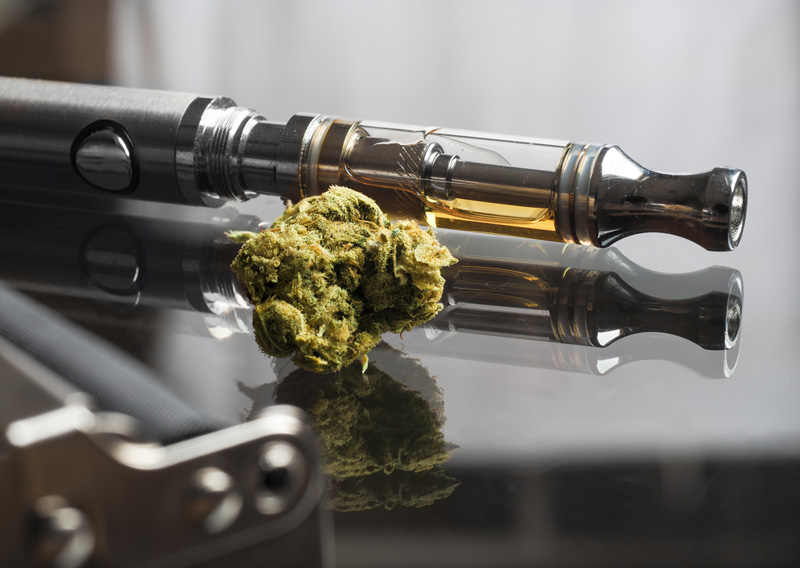Marijuana use has increased recently as it gains the reputation for being a natural, risk-free drug. But it might not be as safe as you think. Marijuana does offer a variety of medicinal health benefits to those managing chronic pain, multiple sclerosis, inflammatory bowel diseases, and chemotherapy. It can also improve sleep quality and reduce anxiety at low doses. But 30% of people who use it are dependent on it, and there are plenty of side effects to consider, especially based on how it’s consumed.

Smoking
Smoking is one of the most popular ways people consume marijuana, which is concerning given it may be the most dangerous. Regardless of how it is smoked (e.g., pipes, bongs, bowls, joints, blunts), it can be detrimental to heart and lung health.
For example, smoking marijuana can increase the risk of high blood pressure, stroke, heart disease, and other cardiovascular diseases, particularly in older adults.
Most notably, smoking can significantly damage lung tissues (e.g., scarred blood vessels, excess mucus, air pockets). Thus, marijuana smokers also have a greater risk of chronic bronchitis and report more health care visits than non-marijuana smokers.
Compared to cigarette smoke, marijuana smoke is more carcinogenic and deposits four times the tar because of different inhalation techniques. Though, there has yet to be a connection to lung cancer. Since there is a lag time of 30-40 years before lung cancer presents itself in tobacco smokers, scientists believe it is only a matter of time before we see the data show it for marijuana smokers as well.
Vaping
A newer consumption method, trendy among adolescents, is vaping. This involves inhaling vapor that is produced by heating dried cannabis flower (“dry herb”), oil concentrates or wax extracts at 160°C-230°C.
When comparing the effects of vaping and smoking, several studies have shown that vaping marijuana eliminates exposure to harmful byproducts created by combustion (e.g., tar, carbon dioxide). Similarly, another study found that vaping dry herb produced a higher ratio of cannabinoids with fewer hazardous compounds.
While seemingly a healthier alternative to smoking, other research shows heating marijuana above 200°C can still expose you to carcinogens, like benzene. Oil concentrate vaporizers with vitamin E acetate are also strongly linked with the lung condition, E-cigarette or Vaping Product Use Associated Lung Injury (EVALI). Despite this, teens are still vaping marijuana and are twice as likely to report wheezing and whistling in the chest than when they smoke tobacco.
Edibles and General Brain Health
Edibles come in many forms such as baked goods or gummies, but despite what you hear, none of them are harmless because of the general impacts of marijuana on brain health.
Marijuana affects brain health by impairing learning, memory, and focus, no matter how it’s consumed. This is why it is particularly dangerous for adolescents and pregnant people to partake. Research shows that users under age 18 have an increased risk of depression and suicidality, and can suffer permanent changes to their developing brain. Babies born to users can also have lower birth weight and behavioral issues.
We also know that marijuana increases the likelihood of developing psychoses (e.g., schizophrenia) and is associated with accelerated brain aging (e.g., smaller hippocampi). All of these negative impacts on brain health are why consuming marijuana edibles isn’t the risk-free golden ticket.
Reducing Harm
There really is no healthy way to consume marijuana: potency has dramatically increased in the last 20 years and research has only scratched the surface on the potential health effects. But there are ways to mitigate some of the risk.
For those who plan to continue smoking, there are a couple ways to soften the blow. It’s important to learn about the materials in your rolling papers before use and avoid holding smoke in your lungs for more than one or two seconds.
For those who choose to vape, consider switching from oil concentrate and wax extract vapes to a less harmful dry herb vaporizer. Make sure to still research the quality of materials in the device, as some are made from low-quality plastic.
For edible users, try limiting your dose and usage altogether. It is also important to stay in a safe place during the high to avoid other standard risks like motor vehicle fatalities.
Although edibles seem to offer the least amount of risk, future studies should explore the long-term impact of all consumption methods. For now, the best ways to protect yourself are to be educated about the risks of marijuana use and minimize its harms whenever possible.
Kristina Carvalho, MSW, is a Policy Analyst, at Partnered Evidence-Based Policy Resource Center (PEPReC), a partnership with the Boston University School of Public Health.
References
- Visé D de. Marijuana use is becoming a new normal among young adults. The Hill. Published October 18, 2022. Accessed June 6, 2023. https://thehill.com/changing-america/well-being/3693312-marijuana-use-is-becoming-a-new-normal-among-young-adults/
- Health benefits of cannabis. Forbes Health. Published February 27, 2023. Accessed June 6, 2023. https://www.forbes.com/health/body/health-benefits-of-cannabis/
- Schauer GL, Njai R, Grant-Lenzy AM. Modes of marijuana use – smoking, vaping, eating, and dabbing: Results from the 2016 BRFSS in 12 States. Drug and Alcohol Dependence. 2020;209:107900. doi:10.1016/j.drugalcdep.2020.107900
- Ahmed W, Katz S. Therapeutic use of cannabis in inflammatory bowel disease. Gastroenterol Hepatol (N Y). 2016;12(11):668-679. Accessed June 6, 2023. https://www.ncbi.nlm.nih.gov/pmc/articles/PMC5193087/
- Vaillancourt R, Gallagher S, Cameron JD, Dhalla R. Cannabis use in patients with insomnia and sleep disorders: Retrospective chart review. Can Pharm J (Ott). 2022;155(3):175-180. doi:10.1177/17151635221089617
- Stoner S. Effects of marijuana on mental health: anxiety disorders. Published online June 2017. https://adai.uw.edu/pubs/pdf/2017mjanxiety.pdf
- Addiction | health effects | marijuana | CDC. Published April 22, 2022. Accessed June 6, 2023. https://www.cdc.gov/marijuana/health-effects/addiction.html
- Cannabis edibles are not as safe as people think. Healthline. Published January 13, 2020. Accessed June 6, 2023. https://www.healthline.com/health-news/cannabis-edibles-health-risks
- Lung health | health effects | marijuana | CDC. Published April 22, 2022. Accessed June 6, 2023. https://www.cdc.gov/marijuana/health-effects/lung-health.html
- Association AL. Marijuana and lung health. Accessed June 6, 2023. https://www.lung.org/quit-smoking/smoking-facts/health-effects/marijuana-and-lung-health
- Abuse NI on D. What are marijuana’s effects on lung health? National Institute on Drug Abuse. Published –. Accessed June 6, 2023. https://nida.nih.gov/publications/research-reports/marijuana/what-are-marijuanas-effects-lung-health
- Will recreational marijuana cause an increase in lung cancer? | hartford hospital | hartford, ct. Accessed June 6, 2023. https://hartfordhospital.org/about-hh/news-center/news-detail?articleid=46820&publicId=395
- Vaughn E. How to talk to teens about vaping. NPR. https://www.npr.org/sections/health-shots/2019/10/06/766971966/how-to-talk-to-teens-about-vaping. Published October 6, 2019. Accessed June 6, 2023.
- Yousufzai SJ, Cole AG, Nonoyama M, Barakat C. Changes in cannabis consumption among emerging adults in relation to policy and public health developments. Substance Use & Misuse. 2022;57(5):730-741. doi:10.1080/10826084.2022.2034873
- Jansen S. What are the health risks associated with dry herb vaporizers? VAPE HK. Published May 14, 2021. Accessed June 6, 2023. https://vape.hk/what-are-the-health-risks-associated-with-dry-herb-vaporizers/
- Gieringer D, St. Laurent J, Goodrich S. Cannabis vaporizer combines efficient delivery of thc with effective suppression of pyrolytic compounds. Journal of Cannabis Therapeutics. 2004;4(1):7-27. doi:10.1300/J175v04n01_02
- Loflin M, Earleywine M. No smoke, no fire: What the initial literature suggests regarding vapourized cannabis and respiratory risk. Can J Respir Ther. 2015;51(1):7-9. Accessed June 6, 2023. https://www.ncbi.nlm.nih.gov/pmc/articles/PMC4456813/
- McPartland JM, Russo EB. Cannabis and cannabis extracts: greater than the sum of their parts? Journal of Cannabis Therapeutics. 2001;1(3-4):103-132. doi:10.1300/J175v01n03_08
- Health CO on S and. Smoking and tobacco use; electronic cigarettes. Centers for Disease Control and Prevention. Published August 3, 2021. Accessed June 6, 2023. https://www.cdc.gov/tobacco/basic_information/e-cigarettes/severe-lung-disease.html
- E-cigarette, or vaping product, use associated lung injury(Evali). Yale Medicine. Accessed June 6, 2023. https://www.yalemedicine.org/conditions/evali
- Boyd CJ, McCabe SE, Evans-Polce RJ, Veliz PT. Cannabis, vaping and respiratory symptoms in a probability sample of United States youth. J Adolesc Health. 2021;69(1):149-152. doi:10.1016/j.jadohealth.2021.01.019
- Schauer GL, Njai R, Grant-Lenzy AM. Modes of marijuana use – smoking, vaping, eating, and dabbing: Results from the 2016 BRFSS in 12 States. Drug and Alcohol Dependence. 2020;209:107900. doi:10.1016/j.drugalcdep.2020.107900
- Brain health | health effects | marijuana | cdc. Published April 22, 2022. Accessed June 6, 2023. https://www.cdc.gov/marijuana/health-effects/brain-health.html
- Gobbi G, Atkin T, Zytynski T, et al. Association of cannabis use in adolescence and risk of depression, anxiety, and suicidality in young adulthood: a systematic review and meta-analysis. JAMA Psychiatry. 2019;76(4):426. doi:10.1001/jamapsychiatry.2018.4500
- Depression treatment | mental health therapy | amen clinics. Accessed June 6, 2023. https://www.amenclinics.com/conditions/depression/
- Treating suicidal thoughts and behavior | amen clinics. Accessed June 6, 2023. https://www.amenclinics.com/conditions/suicidal-thoughts-and-behavior/
- Di Forti M, Quattrone D, Freeman TP, et al. The contribution of cannabis use to variation in the incidence of psychotic disorder across Europe (Eu-gei): a multicentre case-control study. The Lancet Psychiatry. 2019;6(5):427-436. doi:10.1016/S2215-0366(19)30048-3
- Amen DG, Egan S, Meysami S, Raji CA, George N. Patterns of regional cerebral blood flow as a function of age throughout the lifespan. J Alzheimers Dis. 2018;65(4):1087-1092. doi:10.3233/JAD-180598
- Meier MH, Caspi A, R. Knodt A, et al. Long-term cannabis use and cognitive reserves and hippocampal volume in midlife. AJP. 2022;179(5):362-374. doi:10.1176/appi.ajp.2021.21060664
- Stuyt E. The problem with the current high potency thc marijuana from the perspective of an addiction psychiatrist. Mo Med. 2018;115(6):482-486. Accessed June 6, 2023. https://www.ncbi.nlm.nih.gov/pmc/articles/PMC6312155/
- How bad is weed for you? : dangers of long-term marijuana use. American Addiction Centers. Accessed June 6, 2023. https://americanaddictioncenters.org/marijuana-rehab/long-term-effects
- MD PG. If you use cannabis, do it safely. Harvard Health. Published January 17, 2023. Accessed June 6, 2023. https://www.health.harvard.edu/blog/if-you-use-cannabis-do-it-safely-202301172876
- Chaiton M, Kundu A, Rueda S, Di Ciano P. Are vaporizers a lower-risk alternative to smoking cannabis? Can J Public Health. 2021;113(2):293-296. doi:10.17269/s41997-021-00565-w








[…] Read the full article here. […]
[…] Health risks of marijuana. […]
[…] Marijuana use comes along with its own unique health risks. (behavioralhealthnews.org) […]